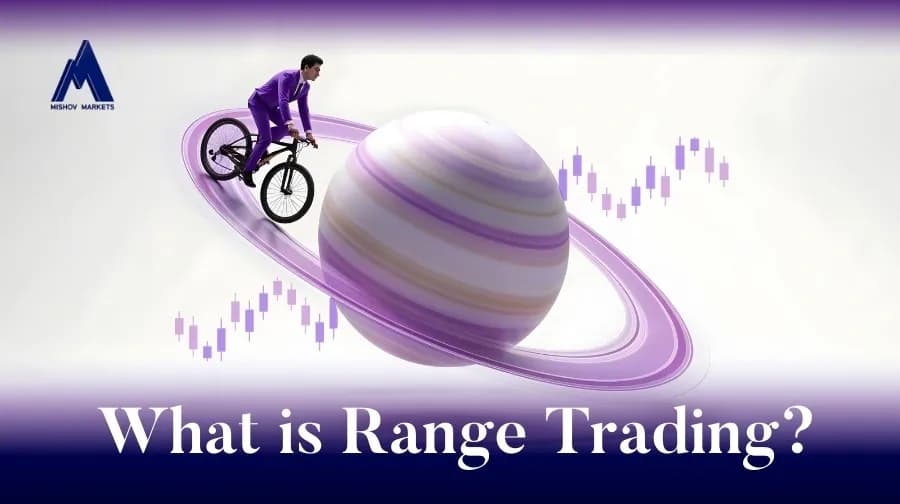What is Range Trading in Forex

Range trading in forex simply means trading within a specified range. If the fast-paced world of scalping makes your heart race a little too much, you’re not alone.
However, many traders find quick trades appealing, only to feel overwhelmed by the rapid decision-making once they are in it. But what if there was a strategy that offered the excitement of trading without the frantic pace? Enter range trading—a method that invites you to slow down, observe, and capitalize on price fluctuations within established boundaries. In this article, we’ll explore how range trading works and how it can lead you to a more measured and strategic approach to the forex market, allowing you to navigate the complexities confidently and clearly.
What is Range Trading?
Forex range trading strategy is a common one, particularly in the foreign exchange and stock markets. Traders focus on identifying a range in which an asset’s price moves between the lower boundary (support) and the upper boundary (resistance). It involves buying at the lower end of a defined price range and selling at the upper end. Unlike trend trading, which relies on price movement in a single direction, range trading aims to profit from price oscillations within boundaries that can be both long or short at different times.
The beauty lies in simplicity and predictability, and that's what range trading offers. It thrives in markets where prices remain stable for extended periods, often because there are no market events or significant news. During times like this, prices fluctuate sideways rather than upward or downward, which makes it ideal for range trading, where traders prefer low volatility or seek consistent, gradual profits rather than significant, risky moves.
How Does Range Trading Work?
Range trading requires a solid understanding of technical analysis. Firstly, traders should identify the range they want to trade (support and resistance levels). Support is a price level where a downtrend pauses due to demand, and traders bounce to buy the asset when the price reaches this level. Conversely, resistance is a price level where an uptrend tends to stall due to excessive selling, prompting traders to sell.
Once traders identify the range, they typically employ the following approach:
Buying Near Support: When the price hits the support level, traders initiate long positions in anticipation of a price rise toward the resistance level.
Selling Near Resistance: When the price approaches the resistance level, traders take short positions, expecting a price decline back toward support.
Use Technical Indicators: To confirm the validity of this range (support and resistance levels), traders often use indicators like the RSI (Relative Strength Index) or MACD. These indicators help determine overbought or oversold conditions, which may signal a potential reversal within the range.
For instance, if the EUR/USD currency pair has been trading between 1.11000 and 1.12000 for several weeks, a range trader would buy at 1.11000 (support) and sell near 1.12000 (resistance) repeatedly, profiting from the price oscillation.
What are the advantages of range trading?
Range trading in forex offers several compelling advantages, including predictability, simplicity, flexibility, and reduced volatility risk, making it an ideal strategy for traders. This approach is more accessible when traders identify clear support and resistance levels; furthermore, it can be applied across various markets like stocks, forex, and commodities. Range trading thrives in stable market conditions, where prices fluctuate within a defined range or limits; this way, traders can profit from small price movements while minimizing exposure to sudden reversals. Additionally, it may be the most suitable strategy for risk-averse traders since the repetitive nature of price movements allows them to execute multiple trades in a short period.
Which Currency is Best For Range Trading?
First, let’s look at Which instruments are suitable for range trading. Several financial instruments are well-suited for range trading. Range traders in stock shares prefer large-cap companies' stocks because they show more stability and trade within established price ranges. Commodities like gold, silver, and oil can also display range-bound behavior, especially during periods of lower volatility. Currency pairs often show predictable support and resistance levels, which has made forex range trading a popular choice.
Now when it comes to currencies, depending on a trader’s approach, the best currency pairs are those with low volatility and stable price movements within a specific time limit. Currency pairs from stable economies (major pairs) are often ideal. For example, EUR/USD is one of the most traded currency pairs globally and is famous for its stability. It usually experiences low volatility, which makes it a favorite among forex range trading strategy traders.
The Swiss Franc (CHF) is considered a safe-haven currency for range traders. The USD/CHF pair tends to trade within well-defined ranges, especially during times of global uncertainty.
AUD/NZD or GBP/CHF are also widely known for frequent movements within predictable ranges.
Is Range Trading Profitable?
If applied appropriately and adequately in the right market conditions, range trading can be profitable. However, its profitability largely depends on the trader’s ability to identify support and resistance levels accurately and to act quickly within the range. Since range trading is all about repetitive price action, traders can make quick and multiple trades and have consistent profits from each oscillation between the boundaries of the range. The profitability can be affected by sudden market breakouts, meaning that the price can break and move out of the support or resistance level, leading to significant losses. To avoid the failure of this strategy, traders use stop loss and often place it just outside the range to protect their positions.
What is the Best Indicator for Range Trading?
Several technical indicators can help with the accuracy of range trading strategies. Some of the most popular ones are as follows:
1. Relative Strength Index (RSI): The RSI is an indicator that helps traders identify overbought and oversold conditions within a range. It shows the average gains compared to losses made and plots them as numbers between 1 and 100.
The reading above 70 would mean that the asset is overbought, which means a potential selling opportunity if the price is near resistance, and readings below 30 suggest an oversold, which means a potential buying opportunity if the price is near support.
2. MACD (Moving Average Convergence Divergence): The MACD can be a valuable tool in range trading, as it helps identify overbought or oversold conditions and potential reversals within a defined price range. Within a range, the MACD histogram is useful for gauging momentum. When the histogram weakens near resistance, it may signal a bearish reversal. Conversely, if it starts strengthening near support, a bullish reversal could be underway.
3. Bollinger Band: This indicator shows a range around the price based on volatility. The bands get wider during high volatility and get smaller during low volatility and the upper band acts like a resistance when the price gets near it, conversely, when the price is near the lower band, it acts like a support zone.
Pros and Cons of Range Trading
|
Pros |
Cons |
|
|
Why is Range Trading popular? What makes it stand out amongst the strategies?
Range trading has remained a favorite for many traders for different reasons. The main reason can be simplicity. Traders especially beginners, are drawn to the straightforwardness of range trading, without the need to analyze complex trends or market shifts. Traders also find range trading very appealing due to its adaptability and consistency. Range trading works well across different markets and timeframes like forex, stocks, and commodities. It can also execute multiple trades within a defined range allowing traders to generate frequent small profits that can add up over time. Furthermore, range trading tends to involve less risk compared to trend-following strategies and that’s why it’s very popular among all levels of traders.








